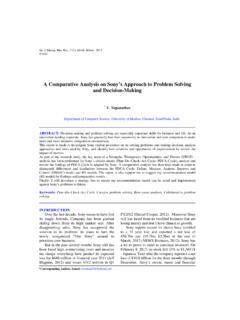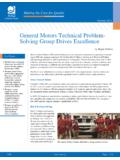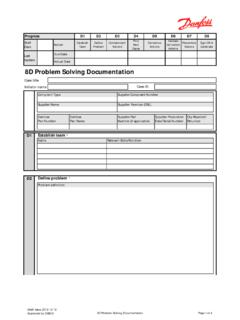Transcription of The 8 Discipline Approach to Problem Solving - IRINFO.org
1 1 The 8 Discipline Approach to Problem Solving Bill Arnott, Owner Level III Infraspection Institute Certified Infrared Thermographer #6357 Apex Infrared RR #7 Owen Sound, Ontario Canada N4K 6V5 Phone: 519-379-2739 Abstract As professional contract thermographers or in-house maintenance staff we are often asked, Why do we keep having the same failures in our equipment? Why does this take so long? Why are costs so high? Understanding and knowing how to get to the root cause of problems is critical to reducing the frequency of problems and ideally to prevent those problems from ever reoccurring. Solving problems effectively demands that a disciplined Approach be used.
2 This paper outlines a process known as 8D Problem Solving and how it applies to a predictive maintenance program. Bill Arnott is a certified 8D trainer and team facilitator and has utilized the process to successfully implement change and to eliminate and reduce costs in many different applications. He will take you through the process, spending time to explain the pitfalls that can cause ineffective solutions to be implemented. A variety of Problem Solving tools will also be explained. Introduction As we go about our daily jobs and deal with the problems that crop up on a regular basis we have a couple of choices, put out the fires over and over or to eliminate the fuel that feeds the fire.
3 With analysis and recognizing pitfalls we begin to see problems in our daily lives. Eliminating the fuel is the preferable route to take but is often the hardest to accomplish. There are many companies out in the world that talk about and teach root cause analysis. Root cause analysis, as it is taught, tends to be theoretical in nature. In a perfect world we follow what we have been taught, find the Problem and put in a solution. However, engineers, thermographers, maintenance personnel and management tend to look at a Problem and want to deal with it quickly and make it go away so that they can deal with the next fire that just occurred.
4 As thermographers and maintenance professionals we are looked at as a source of information with the ability to solve problems. Even though a thermographer s exception report quite often ends with 2 the sentence further investigation required we still need a solid understanding of what our customer may go though investigating that Problem . Solving problems means having a system that forces one to look at everything associated with the issue at hand. Whether we do this in a formal team environment or by ourselves, having a system and being able to recognize the inherent potential pitfalls are critical. In this day of ISO/QS 9000, customer requests, and the need to be competitive, it is necessary to not only know what broke but why it broke and why it keeps breaking.
5 In my experience, when implemented solutions had less than desirable results it was because during the Problem Solving stage, even though all the tools like brainstorming, scatter diagrams, value stream mapping, etc. were followed, one or more of the most common pitfalls were either ignored or not recognized by the team leader and team members. This presentation will deal with the concept of root cause analysis within the 8D process but more importantly will deal with the pitfalls that prevent us from reaching the true root cause and actually eliminating the fuel that feeds the fire. What you will see and hear today is a brief summary of my experience working for a tier one auto parts supplier for over ten years.
6 During that time I held the position of Total Quality Management facilitator and team trainer. I also managed the Kaizen program for that company. In the ten year period that Problem Solving became entrenched into our culture, I either led or facilitated over 150 formal Problem Solving teams and many more informal Problem Solving exercises that saved this particular facility literally millions of dollars. While the money is important, we also increased customer satisfaction and were able to weather cutbacks and downsizing. While we had huge successes we also had some pretty spectacular failures. Today I am going to review the 8D system that is used by most major companies and also review and explain some of the most common mistakes or pitfalls that cause Problem Solving to be ineffective in the long run.
7 As I go, I will attempt to make it as relevant as possible to thermographers and maintenance professionals. Problems are everywhere in our work day. Problems are waste. There are several types of waste in our day. Waste eats up our day by consuming time, energy and resources. How often have we sat back at the end of the day trying to catch our breath and asking ourselves why does this keep on happening? Even though we may have thought through a Problem and implemented a solution it seems that we are rudely pulled from a sense of security months or years later when the same Problem rears its ugly head again. When this happens, how many times have the words I thought we fixed that been spoken?
8 Or we spent a pile of money on that new grapple grommet that was supposed to eliminate that Problem . Even though we may have identified the root cause of the issue we were likely the victims of a pitfall. 3 The 8 disciplines of Problem Solving 1) Form The Team Pitfalls The Wrong People on the Team Quite often we tend to load up the team with professionals who have a world of experience and knowledge. While subject matter experts are needed, it is just as important to have the person who knows nothing about nothing about the Problem . This person brings innocence about the subject to the table and should be encouraged to ask why.
9 I have seen this work very effectively when the person asks why and the only answer from the experts is because or its always been done that way . Experts tend to have blinders on when it comes to their area of expertise and don t see the forest for the trees. By having to explain why something is done or not done, it forces them to analyze the answer. I have seen some remarkable ideas come from people who don t have education, experience or job titles clouding their thought patterns. No Ground Rules Ground rules are critical to the effectiveness of any team whether it is five members or two. Meeting times, task completion, note taking, length of meeting, and agendas are all important.
10 They need to be stated and agreed to at the beginning. The one rule that that I found to be most important is the one person, one vote rule. Just because someone has a bigger business card than someone else does not make their opinion more important. If they have a valid reason for not doing something, then it is their responsibility to explain or show data why that should not be done to the rest of the team. Nothing will sidetrack a team faster than someone who uses their authority to run the team and the results. If that person goes into a Problem Solving exercise with a solution already in mind, then the team concept is the wrong one.









